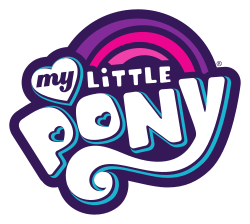My Little Pony
| My Little Pony | |
|---|---|

My Little Pony logo, 2010–present
|
|
| Creator | Bonnie Zacherle |
| Original work | My Pretty Pony toys (1981) |
| Owner | Hasbro |
| Official website | |
| mylittlepony |
|
| My Little Pony (1982–1992) | |
|---|---|
| Original work | Toys |
| Print publications | |
| Comics | |
| Films and television | |
| Films | My Little Pony: The Movie (1986) |
| Animated series |
|
| Television specials |
|
| Miscellaneous | |
| Toys | My Little Pony |
| My Little Pony (1997–1999) | |
|---|---|
| Original work | Toys |
| Games | |
| Video games | My Little Pony: Friendship Gardens (1998) |
| Miscellaneous | |
| Toys | My Little Pony |
| My Little Pony (2003–2009) | |
|---|---|

Logo from the "Generation 3.5" era (until mid-2010, but still used in some countries as of 2011)
|
|
| Original work | Toys |
| Films and television | |
| Direct-to-video |
|
| Theatrical presentations | |
| Musicals | My Little Pony Live: The World's Biggest Tea Party (2006-2008) |
| Games | |
| Video games |
|
| Miscellaneous | |
| Toys | My Little Pony |
| My Little Pony Crystal Princess: The Runaway Rainbow | |
|---|---|
| Developer(s) | Webfoot Technologies |
| Publisher(s) | THQ |
| Platform(s) | Game Boy Advance |
| Release date(s) |
|
| Genre(s) | Adventure/Puzzle |
| Mode(s) | Single-player |
| My Little Pony: Pinkie Pie's Party | |
|---|---|
| Developer(s) | Webfoot Technologies |
| Publisher(s) | THQ |
| Platform(s) | Nintendo DS |
| Release date(s) |
|
| Genre(s) | Adventure/Puzzle |
| Mode(s) | Single-player |
My Little Pony is an entertainment franchise developed by Hasbro, originally as a toy line for girls. The first toys were developed by Bonnie Zacherle, Charles Muenchinger, and Steve D'Aguanno, and were produced in 1981. The ponies feature colorful bodies, manes and a unique symbol on one or both sides of their flanks. Such symbols are referred to in the two most recent incarnations as "cutie marks." My Little Pony has been revamped several times with new and more modern looks to appeal to a new market.
Following the original My Pretty Pony toy that was introduced in 1981, My Little Pony was launched in 1982 and the line became popular during the 1980s. The original toy line ran from 1982 to 1992 in the United States and to 1995 globally, and inspired animated specials, an animated feature-length film, and two animated television series. The first incarnation's popularity peaked in 1990, but the following year Hasbro decided to discontinue the toy line due to increased competition. 150 million ponies were sold in the 1980s.
The toy line was revived in 1997, but these toys proved unpopular and were discontinued in 1999. The brand saw a more popular revival in 2003 with toys that more closely resembled the original toy line, which sold approximately 100 million ponies globally by 2010. Hasbro launched the fourth incarnation of the franchise in 2010, which started with the animated series My Little Pony: Friendship Is Magic. The brand grossed over US$1 billion annually in retail sales in 2015 and 2014, and US$650 million in retail sales in 2013.
The predecessor to My Little Pony was My Pretty Pony, a pony figurine introduced by Hasbro in 1981. It was created by illustrator Bonnie Zacherle and sculptor Charles Muenchinger.My Pretty Pony was a ten-inch-tall hard plastic figurine that could wiggle its ears, swish its tail, and wink one eye. The original My Pretty Pony was followed by My Pretty Pony and Beautiful Baby, which came with an additional smaller "baby" pony figure. This was followed by pink and yellow versions of the original that had the now-hallmark symbol on the ponies' backsides.
After the relative lack of success of the My Pretty Pony toy line, Hasbro introduced six smaller and colorful versions of the toy in 1982, sold under the title My Little Pony. The toy line lead to many more merchandise under the My Little Pony brand, which later became known as the "Generation One" or "G1" of My Little Pony. The pony toys were followed by winged ponies, Unicorn ponies, Flutter Ponies and Sea Ponies. Flutter Ponies were smaller and thinner than Pegasus Ponies, and had fluttering wings. Windy Wing and the Summer Wing Ponies were smaller than the Flutter Ponies and were proportioned in a similar way, with larger, butterfly-like wings. The Sea Ponies resembled seahorses, and were produced as both adults and babies. There were also male ponies called 'Big Brother Ponies', which had slightly larger bodies and feathered hooves resembling those of Clydesdale horses.
...
Wikipedia
